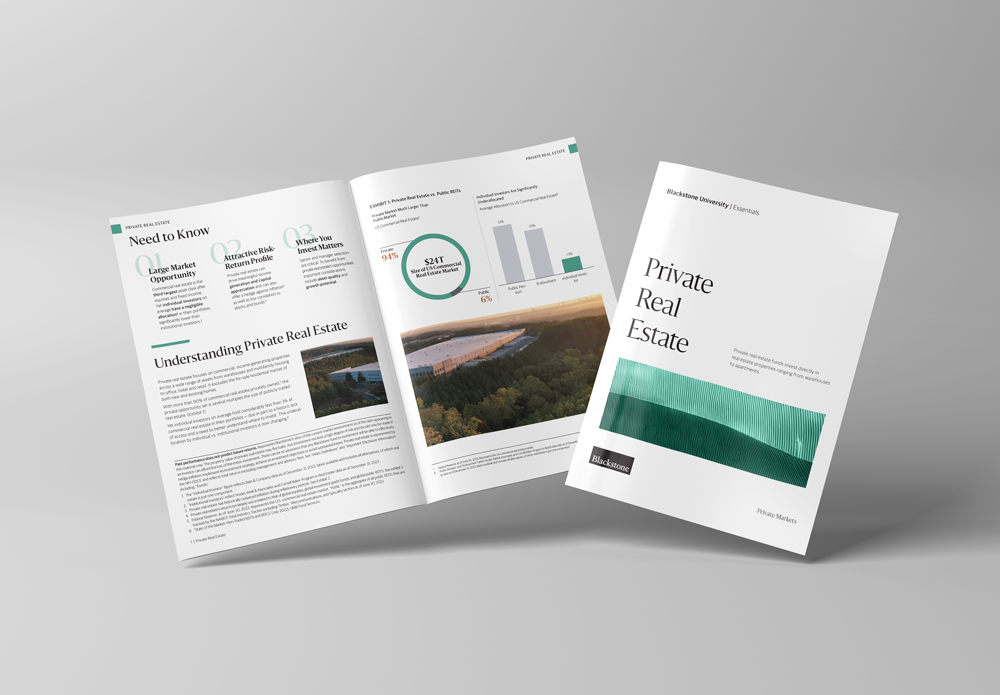
Essentials of Private Real Estate
Download the full brochure
Private Real Estate: What You Need to Know
Large Market Opportunity
Commercial real estate is the third largest asset class after equities and fixed income. Yet individual investors on average have a negligible allocation1 in their portfolios, significantly lower than institutional investors.2
Attractive Risk-Return Profile
Private real estate can drive meaningful income generation and capital appreciation and can also offer a hedge against inflation,3 as well as a low correlation to stocks and bonds.4
Where You Invest Matters
Sector and manager selection are critical. To benefit from private real estate’s opportunities, important considerations include asset quality and growth potential.
Ken Caplan, Global Co-Chief Investment Officer, and Kathleen McCarthy, Global Co-Head of Blackstone Real Estate, discuss the fundamentals of private real estate, key strategies and access to the asset class, along with Blackstone’s investment approach.
Understanding Private Real Estate
Private real estate focuses on commercial, income-generating properties across a wide range of assets from warehouses and multifamily housing to office, hotel and retail. It excludes the for-sale residential market of both new and existing homes.

Data Centers

Industrial

Rental Housing
With more than 90% of commercial real estate privately owned,5 the private opportunity set is several multiples the size of publicly traded real estate. Yet individual investors on average hold considerably less than 3% of commercial real estate in their portfolios1 — due in part to a historic lack of access and a need to better understand where to invest. This underallocation by individual vs. institutional investors is now changing.6
Why Private Real Estate?
Where You Invest Matters
When investing in private real estate, selecting the right sectors, markets and assets is critical to generating strong performance. It is important to focus on high-quality assets with outsized growth potential driven by long-term, secular tailwinds.
This means identifying and concentrating capital around major trends, such as the rise of e-commerce,14 a structural undersupply in housing, or the growth in cloud computing and artificial intelligence.
Manager selection is also critical to success. Blackstone is the world’s largest owner of commercial real estate with a 30+ year track record, serving individual and institutional investors alike.15
Not All Real Estate Is Created Equal16
Cumulative Performance (US Sectors, 2008-2023)

Not all real estate is created equal. Where you invest matters — if you invest in the right sectors even in a more challenging rate environment, you can have a differentiated outcome.
Jonathan GrayPresident and Chief Operating Officer of Blackstone
Unlocking Value Through Private Market Ownership
Private real estate managers may have greater flexibility than public REITs to invest in areas of highest conviction and execute on complex transactions given they are less subject to public market forces. Managers in private markets can more easily drive long-term value- creation opportunities, whereas public market participants may face pressure to achieve predictable quarterly earnings.
A CASE STUDY
High Conviction, Thematic Investing: QTS Data Centers
Capitalizing on Surging Growth in Data Creation
Data Created, Consumed & Stored (Zettabytes)
The privatization of QTS Realty Trust, a ≈$10bn data center public REIT, exemplifies Blackstone’s commitment to high conviction thematic investing, capitalizing on long-term trends in data growth. In fact, more data was created in the last 3 years (2021-2024) than all of history combined.17
Just as e-commerce drove demand for warehouses, cloud computing, content creation and now artificial intelligence are driving the surge in data creation and consumption. Blackstone views the rise of artificial intelligence as a once-in-a-generation engine for future growth in data centers and is committed to unlocking the full power of QTS’ platform through private ownership.

Read the complete Essentials of Private Real Estate


Essentials of Private Markets
Learn how assets such as private real estate, credit and equity can fit into investment portfolios.
- “Individual Investors” reflects data from Bain & Company, of December 31, 2022, latest available and includes all alternatives, of which real estate is just one component.
- “Institutional Investors” reflects data from Hodes Weill & Associates and Cornell Baker Program in Real Estate, as of December 31, 2023.
- Private real estate has historically outpaced inflation during inflationary periods. Any investment involves a high degree of risk and should only be made if an investor can afford the loss of the entire investment.
- Private real estate’s returns are largely uncorrelated to that of equities, investment grade bonds, municipal bonds and public REITs. Any investment involves a high degree of risk and should only be made if an investor can afford the loss of the entire investment.
- Federal Reserve, as of June 30, 2023. Represents the U.S. commercial real estate market. ”Public” is the aggregate of all public REITs that are tracked by the NAREIT Total Industry Tracker excluding Timber, Telecommunications, and Specialty sectors as of June 30, 2023.
- “State of the Market: Non-Traded REITs and BDCs” (July 2022), UMB Fund Services.
- Federal Reserve, as of June 30, 2023. Represents the US commercial real estate market.
- “Public Pension” and “Endowment” reflects data from Hodes Weill & Associates and Cornell Baker Program in Real Estate, as of December 31, 2023. “Individual Investor” reflects data from Bain & Company, as of December 31, 2022, latest available and includes all alternatives, of which real estate is just one component.
- Diversification does not ensure a profit or protect against losses.
- NCREIF, 20-year period ending December 31, 2023. Reflects the NFI-ODCE Index. Represents Blackstone’s view of the current market environment as of the date appearing in this material only. Past performance does not predict future returns. There can be no assurance that any Blackstone fund or investment will be able to implement its investment strategy, achieve its investment objectives or avoid substantial losses. There can be no assurance that the trends described herein will continue or not reverse. Performance data shown represents the performance of an index and not that of the Strategy. The Strategy distributions are not guaranteed and may be funded from sources other than cash flow from operations, including borrowings, offering proceeds, the sale of the Strategy assets and repayments of the Strategy real estate debt investments. The Strategy has no limits on the amounts it may fund from such sources. NFI-ODCE quotes returns including leverage and fund expenses but excluding management and advisory fees. Returns net of management and advisory fees would be materially lower. It is not possible to invest in an index.
- Net operating income (“NOI”) reflects Green Street Advisors data, as of December 31, 2023. 2023 NOI growth represents year-end estimate as of April 02, 2024. U.S. CPI reflects Bureau of Labor Statistics data, as of December 31, 2023. NOI growth represents the average NOI growth by year across the equal-weighted average of the asset-weighted average of the multifamily, industrial, mall, office and shopping center sectors. Multifamily refers to apartment; shopping center refers to strip retail. The Consumer Price Index (CPI) measures changes in the prices paid by urban consumers for a representative basket of goods and services. NOI may not be correlated to or continue to keep pace with inflation.
- Morningstar Direct, NCREIF, 20-year period ending December 31, 2023. Represents Blackstone’s view of the current market environment as of the date appearing in this material only. Past performance does not predict future returns. Diversification does not assure a profit or protect against a loss in a declining market. Indices are meant to illustrate general market performance. Comparisons shown are for informational purposes only, do not represent specific investments and are not a portfolio allocation recommendation. Correlation measures how one investment performs in relation to another, with a coefficient of +1 being a perfect, positive correlation and a coefficient of -1 being a perfect, negative correlation. When two asset classes have a correlation of +1, they will both move up or down by the same amount in the same direction. Conversely, a correlation of -1 indicates that when one asset class moves up or down, the other moves in the opposite direction by the same amount. In general, asset classes with a correlation of less than 0.70 or greater than -0.70 are considered to have relatively low correlation. Private real estate is represented by the NFI-ODCE. Public REITs are represented by the total return of the MSCI U.S. REIT Index. Equities are represented by the total return of the S&P 500 Index, including dividends. Investment grade bonds are represented by the total return of the Bloomberg U.S. Aggregate Bond Index. Municipal bonds are represented by the Bloomberg U.S. Municipal Index.
- Past performance does not predict future returns. Morningstar Direct, NCREIF, as of December 31, 2023. Represents Blackstone’s view of the current market environment as of the date appearing in this material only. There can be no assurance that any Blackstone fund or investment will be able to implement its investment strategy, achieve its investment objectives or avoid substantial losses. Indices are meant to illustrate general market performance. Comparisons shown are for informational purposes only, do not represent specific investments and are not a portfolio allocation recommendation. An investment in a yield-oriented U.S. Core+ Strategy for income-focused individual investors (the “Strategy”) has material differences from a direct investment in real estate, including related to fees and expenses, liquidity and tax treatment. The Strategy’s share price is subject to less volatility because its per share NAV is based on the value of real estate assets it owns (which may fluctuate and may be worth less than initial price) and is not subject to market pricing forces as is the price of the indices presented. The Strategy shares are significantly less liquid than public REITs and may fluctuate. Private real estate is represented by the NFI-ODCE and reflects total returns excluding management and advisory fees. Public REITs are represented by the total return of the MSCI U.S. REIT Index. Equities are represented by the total return of the S&P 500 Index, including dividends. Investment grade bonds are represented by the total return of the Bloomberg U.S. Aggregate Bond Index. 10-Year U.S. Treasury is represented by the Bloomberg 10-Year U.S. Treasury Bellwethers Index and is subject to interest rate risk. Municipal bonds are represented by the Bloomberg U.S. Municipal Index.
- U.S. Census Bureau, as of December 31, 2023. E-commerce growth represented by the increase in e-commerce sales from the year ended December 31, 2015 to the trailing one-year period ended December 31, 2023..
- World’s largest owner of commercial real estate based on estimated market value per Real Capital Analytics as of March 31, 2024.
- Green Street Advisors, as of December 31, 2023. Based on the Green Street Commercial Property Price Index, which captures the prices at which U.S. commercial real estate transactions are currently being negotiated and contracted. Reflects percent change by property sector from January 1, 2008 to December 31, 2023. Shopping center refers to strip centers, and hospitality refers to lodging.
- International Data Corporation (IDC), as of December 31, 2021. 2021-2024 represent year-end estimates.
